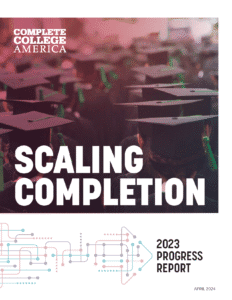
The 2023 CCA Progress Report
2024 marks CCA’s 15th anniversary. What started as a bold idea that we must see—and count—every student and that access to college alone was not enough to improve student success has grown into a national movement. Together with our Alliance members and partners, we are scaling highly effective structural reforms and implementing policies so all students, no matter their lived experiences, can earn a degree or credential of value on time. This report provides highlights of our work in 2023 and sets the stage for how we will build on that progress in the coming year.
Scaling Completion highlights CCA’s work in 2023 to:
- Lead the field to improve college completion rates, particularly for historically underserved students.
- Engage and bring together leaders to eliminate institutional performance gaps.
- Build capacity to create and implement data-informed transformative policies and practices.
The report also takes a look at our growing impact since our founding in 2009, including increases in the number of degrees and certificates conferred, the numbers of students served, and graduation rates at two- and four-year institutions.
